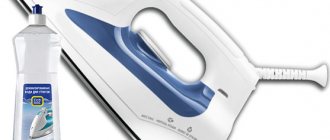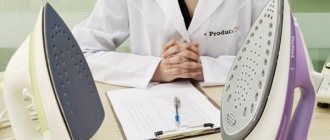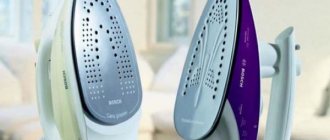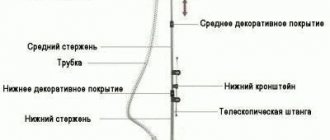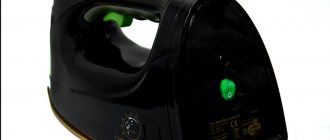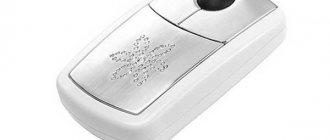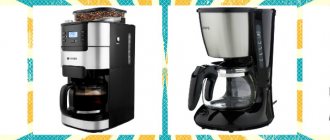An iron is a fire hazard, and we have already written about this in detail. If used incorrectly, it can burn through the fabric, or even the ironing board, stick to clothes so that you cannot remove it, and over time it becomes covered with soot, which happily melts into your white shirt. Modern manufacturers are struggling with the problem by creating new sole material - the very part with which we iron. In this article, we will try to figure out which sole it is better to choose an iron with, so that things suffer as little as possible.
Of course, it would be useful to remind you: follow the ironing recommendations indicated on the product tag, and try to choose the proper temperature setting suitable for the fabric you are ironing.
- Which sole is considered the best?
- Aluminum: cheap and very cheerful
- Stainless steel: strong and inexpensive
- Teflon: does not spoil things until the first scratch
- Ceramics and metal ceramics
- Titan: An Unexplored Innovation
Which iron sole is considered the best?
The requirements for sole material are not so great. A good material glides easily over the fabric (that is, it should be as smooth as possible), durable, heats up evenly and is gentle on clothing, while smoothing out wrinkles.
Modern irons can have the following soles: aluminum, stainless steel, Teflon, ceramics, cermet and titanium. In addition, there are proprietary alloys, such as Eloxal or Sapfir from Braun.
Let's try to consider each of them from the point of view of the requirements that the best sole material should have - and figure out what to take.
Teflon
This is one of the most popular models on the market today. Loyal price and attractive design ensured strong consumer demand for irons with Teflon soles
. It is also important for users that models with Teflon soles heat up very quickly, almost instantly.
At the same time, the heat lasts for a long time even after the switch has switched the device to the minimum power consumption mode. That is, during operation they practically do not cool down.
The Teflon coating completely duplicates the qualities of aluminum soles. They are also easy to glide and have a non-stick coating. In addition, just like its aluminum counterparts, Teflon is easily deformed and scratched.
The models are distinguished by maneuverability and ease of use. Teflon samples are convenient for processing large volumes of laundry, so they are often used in hotels and hospitals
.
Aluminum: cheap and very cheerful
Aluminum is the first sole material for electric irons (before that they were made of coal and cast iron). It is a very light and soft metal that sands well, so aluminum soles are perfectly smooth.
In addition, this metal is almost instantly heated by electricity to the desired temperature. Therefore, many modern inexpensive irons have soles made of this material. For example, this Philips Azur, which we cited as an example:
However, that's where the benefits end. Due to the softness of aluminum, the soleplate is very easy to scratch, and damage reduces the quality of ironing. In addition, it is this metal fabric that can be “smoothed” to a shine that no amount of washing can remove.
By the way, modern manufacturers fight this with the help of a special aluminum treatment - anodizing. If it is indicated that the sole is made using Careeza, Anodilium or Eloxal technologies, then that is what it is. This Braun iron has a patented Eloxal Plus sole:
But rapid heating has too many risks: if you set the temperature incorrectly, your silk blouse will instantly stick. Therefore, in the rating of sole materials for irons, aluminum is most likely at the bottom.
Nickel
This material is typically applied to steel soleplates as a non-stick coating.
The distinctive qualities of these models are their slightly gilded shine.
.
Therefore, they look like premium devices. They are easy to use and can be cleaned with a soft cloth and ordinary vinegar.
These models are maneuverable and very resistant to anti-corrosion processes. However, if scratches appear, it will be almost impossible to remove them. This affects the quality of ironing, since scratches tend to cling to the fabric. This has a particularly detrimental effect on products made of chiffon, natural silk and cambric.
Stainless steel: strong and inexpensive
The most popular iron sole material is stainless steel. Strength and resistance to corrosion allow it to be considered one of the most successful materials for the soles of irons, especially steam ones.
In addition, steel smoothes out any wrinkles well without “smoothing”, and also heats up quite quickly. This is again both a plus and a minus - as soon as you forget the iron, sole down, on the ironing board, and behold, the board is already “fried.”
Irons with steel soles are quite heavy - this is not surprising, because steel has never been a light material. Although compact models weigh less than a kilogram, for example, this small Scarlett iron:
How gentle is stainless steel on fabric? Unlike aluminum, if the temperature is violated, it does not stick, but “leaves a burn” on the fabric. Of course, after this the item can also be considered hopelessly damaged, but the damage is still less - at least the iron will remain intact.
Sole shape: which one to choose?
The nose, the area, the shape of the back of the sole - everything is important!
A sharp nose is needed to easily iron difficult places: shirt sleeves, dress frills, collars, cuffs and the space between buttons. For children's clothes, a narrow iron spout is simply irreplaceable. For large items, and especially for bed linen and tablecloths, wide irons with a rounded nose are more convenient. Still, for home use it is better to choose a more versatile model with a pointed nose.
Be sure to take a closer look at the back of the iron sole: if it is rounded, then wrinkles will not form as you move. This is especially true when driving in reverse.
The thin edge of the sole, slightly protruding forward, allows you to place the device under buttons or embroidery without melting the plastic fittings.
Teflon: does not spoil things until the first scratch
The only difference between these irons is the coating: a non-stick layer is applied to an aluminum or steel sole. Everyone knows the advantages of Teflon frying pans: it is extremely difficult to burn anything with them when cooking. This also applies to irons, so a Teflon iron can be called gentle on fabric.
The Teflon coating is smooth and glides easily. Teflon on aluminum is less effective at smoothing out wrinkles than on metal. So if you buy a Teflon iron, then on a metal backing, for example, like this:
But where the disadvantages of Teflon are hidden is in its poor resistance to contact with metal parts. By analogy with Teflon frying pans, the sole of a Teflon iron is easily scratched and immediately loses its non-stick properties, and things begin to “burn”. In addition, it is these models that especially “love” to become covered with soot. Fortunately, with most modern models it can be washed off with a regular rag.
But there is good news: Teflon irons include Braun irons with Sapfir coating. Sapfir soles are made of a stainless alloy, onto which a special coating of corundum powder is applied, which is akin to sapphire (sapphire chips are a marketing ploy). Thanks to this, they not only acquire non-stick properties, but also significant resistance to damage. If you are wondering which iron coating is better, then Sapfir is at least close to ideal. For example, this Braun iron has just such a sole:
Materials used in soles
The first thing you need to pay attention to in order to choose a high-quality sole is the material from which it is made. Almost all products are made of steel or aluminum and differ only in the coating. Today there are several main options for outsole coating:
- Aluminum coating;
- Ceramic coating;
- Teflon coating;
- Stainless steel cover.
Each of the materials has its own advantages and disadvantages. It is worth considering each of the options in detail to choose the one that suits you.
Ceramics and metal ceramics
Ceramic or metal-ceramic coating of the sole is quite popular. Customers like ceramic soles based on the same principle as Teflon ones: nothing sticks to ceramics.
Ceramic irons provide easy gliding, while metal-ceramic irons also provide high quality ironing due to a heavier sole. The corresponding models are not very expensive. This Galaxy iron will cost less than a thousand:
However, ceramics is an even more fragile material than Teflon. Both it and metal ceramics require very careful handling. Any damage - for example, dropping an iron - or a scratch quickly leads to peeling of the ceramic coating, and with it, “burns” on the clothes.
In addition, carbon deposits also form on ceramics, and they are so corrosive that removal requires a special cleaner for irons. An exception was invented by Tefal - the Ultragliss Diffusion sole, which can be cleaned with a regular damp cloth:
Basic requirements for soles
The shape, area and material of the platform, along with such parameters as the power and weight of the electric iron, are one of the main factors when choosing a particular model. All customers want the iron to glide well and quickly smooth any material - both thick outerwear fabric and delicate textiles.
It is believed that a good iron coating must meet several requirements:
- Easy glide. The foot should move smoothly, without applying additional effort, over the surface of different types of fabrics. The lower the friction force of the platform on the fabric, the higher its quality indicator.
- High- quality smoothing is the main function of every electric iron. Its working base is designed to gently act on fabric fibers without damaging their structure. Any material must be straightened properly so that no gloss, folds, creases or other defects remain on its surface. Textile fibers should not burn or melt under the influence of the sole.
- Strength. The durability of the platform depends on this characteristic. Its surface periodically comes into contact with locks, buttons, rivets and other fittings located on clothing. If the footrest is made of soft material, it will become damaged over time. As scratches and chips appear, the quality of ironing becomes worse. This is why the sole must have a durable surface.
- Fast, even heating and cooling. The lower the thermal conductivity of the material, the longer it takes to heat up. This leads to increased energy consumption and irritates overly impatient users. In addition, a slow response to changes in temperature can lead to damage to the tissue structure. In order to smooth the fabric efficiently, the base of the iron must have the same temperature over the entire surface.
- Easy and simple care. It is important that every housewife can easily remove burnt marks from the surface using available means.
The same manufacturer - Philips - produces irons with different types of platforms
General information
One of the modern variety of materials is ceramics . This is a fairly young type of iron sole, which is gaining popularity and has found its place even among representatives of steam stations. To be more precise, you won’t find pure ceramic soles. Any similar product is aluminum, steel and their alloys coated with ceramic enamel. But the sole is considered ceramic, since it is the enamel that comes into contact with things.
Such material takes different times to heat up in different models, but it retains heat for a long time , and this is a good saving of energy, and therefore savings. Another type of ceramic sole is cermet. It contains strips of metal, which extends the service life of the product and makes it more resistant to mechanical damage. When choosing an iron model, you should pay attention not only to what material the sole is, but also to its width and shape.
A significant advantage will be the rounded back of the iron , since it will not wrinkle the fabric when moving backwards, and the sharp nose will help to effectively iron ruffles or areas around buttons. The number of holes in the soleplate of the iron also plays a role. The more there are, the more effective the use of this electrical appliance will be.
Features of stainless steel soles
Stainless steel is famous for its high thermal conductivity and durability. For many years, irons with stainless steel soles have been in demand on the market and are not going to lose ground. Some manufacturers, in an effort to improve the consumer qualities of their devices, use additional coating for the stainless steel sole: chrome, titanium, enamel or sapphire. The chrome-plated sole glides perfectly, and the enamel or titanium layer provides non-stick properties. The most expensive coating - sapphire - provides a higher level of wear resistance of the working surface.
Advantages of ceramic soles
The significant advantages of ceramic soles include:
- Easy glide : manufacturers call it ultra-glide. When using an iron with a ceramic sole, the fabric does not cling to it, does not wrinkle or create additional folds, especially when moving backwards. Even types of materials such as linen and cotton are easily ironed. This greatly simplifies the ironing process and saves a lot of time.
- Easy to clean : you can clean the surface of the ceramic sole either with a simple damp soft cloth (for light stains) or with special products that will not scratch the enamel.
- Average price category : such irons are slightly more expensive than those that have a metal sole, but are inferior to titanium and sapphire-coated composite materials. Therefore, the price of such products is considered affordable.
- Uniform heating of the sole : the heating element in such an iron is often a heating element, less often a spiral. When you have to iron already dried clothes or bed linen, this option comes in handy.
- Long-term temperature retention : allows you to use electricity economically, since the ceramic surface conducts heat well and retains it on the surface for a long time.
- Light weight : an iron with a metal-ceramic or ceramic sole weighs no more than one and a half kilograms. This criterion helps you effortlessly work with everyday clothing and lightweight materials.
Iron selection criteria
The development of the technological process contributes to the emergence of new models of irons. Today, such technology is absolutely different from its ancestors. A good iron should guarantee high-quality ironing, be functional, safe, lightweight, and as convenient as possible to use.
Irons come in different types: professional (used in studios and retail establishments), special equipment for dry cleaners, laundries, and equipment for household needs. The latter, in turn, are divided into simple, road and steam.
A simple iron is equipped with a thermostat that regulates the heating of the soleplate. However, this technique does not have the function of moistening the laundry, so today such models are irrelevant and are practically not produced. Travel options are small in size, easily fit in bags, and have a minimal number of functions. Steam irons are the most popular, they cope well with dry or wet ironing, and have many additional modes.
When choosing such household appliances, it is recommended to pay attention to power. Irons come in low power (below 1600 W), medium power (1600 to 1900 W) and high power (over 1900 W). The best choice for a family of several people is a medium-power iron. This device is considered quite economical and will cope well with ironing a large amount of laundry. The length of the cord and its fastening affect the comfort of ironing. It is better to choose an iron with a hinged flexible mount that allows the cord to rotate in any direction.
The surface of the iron has special holes through which steam is supplied. The uniformity of its supply affects the quality of ironing. The automatic shut-off function will automatically turn off the device after some time, preventing damage to the fabric. The presence of special anti-lime rods or cassettes with resin and a self-cleaning function will solve the problem of scale formation. Models with an anti-drip system will prevent water from getting onto the fabric.
Ceramic coatings
Ceramic coatings have the most attractive appearance. They are easy to care for and can be easily cleaned with a simple damp sponge. Such a sole can provide the iron with the best glide over the fabric. This makes the ironing process comfortable and fast. The heating time of such material is not very fast, but it retains heat well. This allows you to significantly save on electricity. There is a new approach to such coatings - ceramic enamel is applied in transverse stripes alternately with metal. The ribbed texture of such a sole will allow you to cope even with overdried laundry.
The most global disadvantage of ceramics is its fragility. Even with the most careful treatment, chips and scratches will inevitably appear on the surface. Subsequently, this can lead to peeling of the enamel and the appearance of difficult-to-remove carbon deposits.
Varieties of forms
In addition to the material of the ironing surface, the configuration and area of the sole are equally important. At first glance they seem the same, but in fact they differ in outline. The variety of models is due to the fact that manufacturers are experimenting, trying to find which shape of the iron sole will be better for ironing.
Types of working surfaces:
- with a pointed nose. Tapered top irons are great for ironing small parts, hard-to-reach areas and areas near hardware;
- with a rounded (blunt) nose. Irons are best used for large items: bed linen, towels, tulle;
- with a rounded back. Such models do not wrinkle laundry during the return motion;
- with corners at the edges of the bottom. When working with irons of this shape, care and smooth movements are required. Otherwise, when ironing, persistent bruises will form;
- with a groove around the perimeter. A notch at the base allows you to smooth out the material under sewn fittings or overlays; wide sole.
Advice! To save energy consumption and reduce ironing time, you should choose irons with a wide working surface. The larger its area, the faster you can iron your laundry.
Teflon surfaces
Teflon gained its fame after it began to be used to coat dishes. It is not used as often as a coating for irons, but there are such models. The main advantage of Teflon coatings is the elimination of sticking to fabric. With such an iron it is impossible to burn and damage the item.
All the advantages of this option are negated by its susceptibility to scratches. Ironing ordinary everyday clothes with buttons and zippers is sometimes almost impossible. Scratches will appear even from the slightest contact. That is why Teflon coating has almost ceased to be used in the production of irons.
Options
When thinking about which iron soleplate is the best, you need to pay attention to the following important factors:
- Simplicity and ease of sliding. The device should move without tension or effort;
- Gentle contact with fabric. The technique should better smooth out wrinkles, but not leave stains, creases or other defects;
- Heating uniformity. The same temperature must be maintained at all points of the device - this avoids tissue damage;
- Strength. Not a single household appliance is protected from mechanical or force influence; in addition, during the ironing process, the device bumps into hard fittings;
- Easy to use and maintain. The surface material should not accumulate carbon deposits or catch fibers - but should be easy to clean with available means.
It is these performance characteristics that should be carefully studied before making a purchase; it is better to focus on them in order to understand which sole for the iron is better, what it should be.

